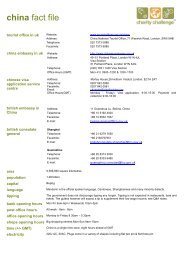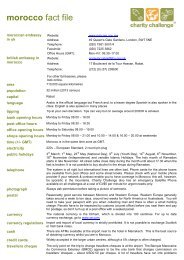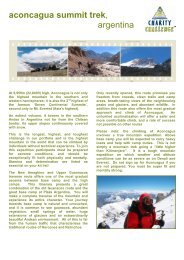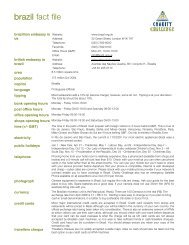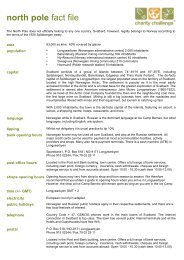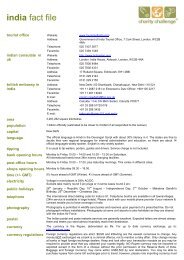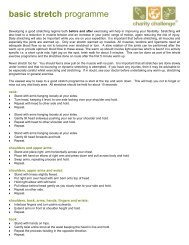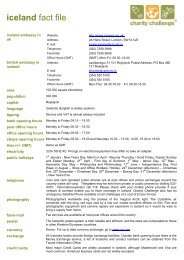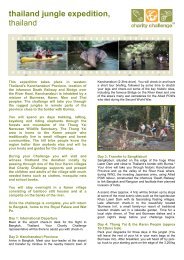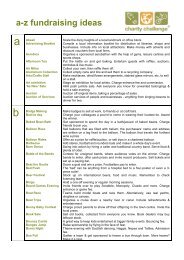Nepal Fact File - Charity Challenge
Nepal Fact File - Charity Challenge
Nepal Fact File - Charity Challenge
You also want an ePaper? Increase the reach of your titles
YUMPU automatically turns print PDFs into web optimized ePapers that Google loves.
nepal fact file<br />
nepal embassy in uk Website: www.nepembassy.org.uk<br />
Address: 12A Kensington Palace Gardens, London, W8 4QU<br />
british embassy in<br />
nepal<br />
area<br />
population<br />
capital<br />
language<br />
tipping<br />
Telephone: 020 7229 159400/6231/5352<br />
Facsimile: 020 7792 9861<br />
Office Hours (GMT): Mon–Fri: 0930–1300 & 1400–1750<br />
Website: www.britain.gov.np britemb@wlink.com.np<br />
Address: PO Box 106,Lainchaur, Kathmandu, <strong>Nepal</strong><br />
Telephone: +977 (1) 4410583/4414588<br />
Facsimile: +977 (1) 4411789/4416723<br />
Office Hours (GMT): Mon - Thurs 0815 – 1700 and Friday 0815 – 1315<br />
1,471,81 Square Km.<br />
Approx. 26.46 Million<br />
Kathmandu<br />
<strong>Nepal</strong>i<br />
Small dollar or <strong>Nepal</strong>ese rupees are needed, i.e.: 20 rupees for a porter to take your bag to your<br />
hotel room, 10% on restaurant bills.<br />
bank opening hours 9am to 3pm (Monday to Friday)<br />
post office hours<br />
9am to 5pm (Monday to Friday)<br />
office opening hours 9am to 5pm (Monday to Friday), in rural areas Sun-Thurs 10am-5pm, Fri 10am-3pm<br />
shops opening hours Roughly 10am to 6pm<br />
time (+/- gmt)<br />
electricity<br />
public holidays<br />
telephone<br />
photograph<br />
postal<br />
currency<br />
credit cards<br />
travellers cheque<br />
passport/visa<br />
+5hr 45 mins<br />
220 Volts & 50 Cycles<br />
Saturday (and sometimes Sunday)<br />
The international direct dialling code for India is +977. Please check with your mobile phone<br />
provider if your network & contract enable you to have coverage in <strong>Nepal</strong>. <strong>Charity</strong> <strong>Challenge</strong> also<br />
has a Satellite Phone. The Satellite Phone is for emergencies only and battery life is limited by the<br />
cold temperatures.<br />
You will find it hard to buy camera film outside of Kathmandu and Namche Bazaar. You can<br />
charge digital cameras at the tea houses you have your evening meals in for a small fee (100-200<br />
rupees per hour), please bring a plug adapter.<br />
GPO is situated at Sundhara. Best to post through your hotel or a major bookshop.<br />
Rupiya (<strong>Nepal</strong>ese rupee). For up to date currency exchange, go to www.xe.com.<br />
Accepted in all major hotels, banks and stores in Kathmandu and Pokhara. Make sure you know<br />
your pin number before leaving home. Please note that ATMs are not always available and that<br />
when they are they do not always work. It is generally easier to visit a bank, but your local guide will<br />
advise.<br />
As for credit cards in USD and GBP denominations.<br />
You must hold a full ten-year passport with at least six months to run from the end of your<br />
expedition. Airlines may not carry passengers holding passports with less than 6 months validity.<br />
We will provide you with a visa application form or you can download one from the embassy<br />
website - www.nepembassy.org.uk/visa_information.html. The validity of visa dates are counted<br />
from the date of arrival in <strong>Nepal</strong>. You should apply about 12 weeks before departure for a singleentry<br />
tourist visa. Do not apply too early otherwise it will run out before you leave for <strong>Nepal</strong>. It is<br />
valid for six months from the date of issue. The visa is valid for 60 days on entry and costs £20.<br />
Also see Travel Tips & your visa letter 3 months prior to departure.
gifts & souvenirs<br />
duty free<br />
vaccination &<br />
health<br />
Gifts and Souvenirs can be bought and taken out from the country, except for antique more than<br />
100 years old.<br />
Available at Tribhuwan International Airport, Kathmandu.<br />
Nomad Travel Stores Medical Centre recommends the following vaccinations: hepatitis A; typhoid;<br />
diphtheria; tetanus; poliomyelitis. Vaccines sometimes advised: hepatitis B; rabies; tuberculosis;<br />
meningococcal meningitis; Japanese B encephalitis (for eastern and low lying areas); cholera.<br />
Malaria precautions are essential in all areas below 1200m, all year round. The risk in Kathmandu<br />
and mountainous areas of similar or greater altitude is very small. Check with your doctor or nurse<br />
about suitable anti-malarial tablets. It is imperative that you drink at least 5 litres of water per day to<br />
limit the effects of dehydration and to combat the effects of altitude sickness. High altitude (usually<br />
from 10,000ft upwards) can cause headaches and dizziness, but the gradual acclimatisation<br />
process of this itinerary will help to prepare you for the altitudes. Also see Health notes.<br />
risks Unpredictable weather, cancellation or delay of internal flights, emergency evacuation can lead<br />
to a re-route of our original itinerary.<br />
Landslides affect <strong>Nepal</strong> during the monsoon season (July-September), and flooding may also<br />
occur. Both can cause major disruption to travel during the summer months.<br />
<strong>Nepal</strong> is an earthquake zone. Although no major earthquake has struck <strong>Nepal</strong> since 1934, the<br />
possibility still exists.<br />
Delays caused by army checkpoints on roads.<br />
Very small but slight risk of encounters with Maoist insurgents if travelling in certain rural areas<br />
such as the Annapurna region, to date where these have occurred it has usually involved paying<br />
a ‘tax’ (up to $100) without any physical violence.<br />
hospitals/<br />
pharmacies<br />
water<br />
climate<br />
temperature<br />
geography<br />
culture/customs<br />
In Kathmandu there are major government-run and private hospitals. Pharmacies are widely<br />
available in all big towns and cities. Health Posts are found in major villages like Lukla, Namche<br />
Bazaar, Khunde and Pheriche.<br />
Water is NOT safe to drink straight from the tap, rivers or creeks. Chlorine-based purification tablets<br />
are only 50 to 60% effective on Himalayan water. Iodine or Lugol’s solution (available locally) works<br />
100% but leaves a slightly metallic taste. Plastic bottled water is not recommended for Eco-trekking<br />
purposes. On trek we serve safe boiled drinking water, the safest way to stay healthy while on<br />
treks. Also see Health notes.<br />
The cold, dry, clear winter season runs from October to March, and the warm, dry spring season<br />
from March to June. The wet season, or monsoon, lasts from roughly June to September,<br />
depending on the year. Mid-September to mid-October is the start of the dry season. Please see<br />
the Everest Q&A for more detailed information on weather conditions in <strong>Nepal</strong>.<br />
Highly dependent on altitude and season, so charts are little use. Kathmandu temperatures can<br />
drop to a few degrees centigrade on winter nights, and reach about 30 degrees centigrade shortly<br />
before the monsoon. In the mountain temperatures rarely exceed 25 degrees, but can plummet far<br />
below zero. Plains areas are roughly 5-10 degrees centigrade hotter than Kathmandu.<br />
Located between India and China at latitudes 26 and 30 degrees North and longitudes 80 and 88<br />
degree East. <strong>Nepal</strong> is topographically divided into 3 regions; the Himalayas (mountains), the pahad<br />
(middle hills) and the Terai (plains).<br />
Most <strong>Nepal</strong>is are Hindu, especially in the capital and plains areas. The Middle Hills are mixed areas,<br />
with Hindu castes, predominantly Chhetri, living among ethnic groups (possibly of Tibetan origin)<br />
such as Gurungs, Magars, Tamangs, Rais and Limbus who practice various mixtures of Hindu,<br />
animistic and Shamanic practices. Buddhist groups such as Sherpas and Tamangs live in mountain<br />
areas.<br />
do’s & don’ts Do learn the lingo! The formal greeting in <strong>Nepal</strong> is "Namaste", performed by joining the palms of<br />
the hand together in front of the face; it's usually considered overly formal for chance<br />
encounters on trails – try a hearty "oho!" Equally, "dhanyebaad" is too formal for most ‘thank<br />
yous’ - you can use an English "thank you" instead, or just smile. With its diverse ethnic groups<br />
and traditional beliefs <strong>Nepal</strong> has numerous cultural practices. The best advice is to watch what<br />
other people do, though even if you get it wrong, most <strong>Nepal</strong>is are very understanding.<br />
Do be aware of local customs. Hindus consider certain objects as ritually impure: shoes<br />
(remove them when entering homes or religious places, and avoid touching anyone with your<br />
feet, or stretching your legs out showing the soles); eating utensils (avoid sharing food with<br />
Hindus, or any utensil or water bottle that you've touched with your lips); and the left hand<br />
(avoid pointing at or touching people with it, especially on the head).<br />
Do seek permission before entering temples and note that walking around temples and<br />
monasteries is traditionally done clockwise.<br />
Don’t show affection towards another in public, as displays of affection between men and<br />
women in public are frowned upon.<br />
Don’t get involved with drugs. Drugs are illegal and frowned on by most <strong>Nepal</strong>is. Possession of<br />
very small quantities can lead to imprisonment.<br />
Don’t overstay your visa. If you do, you may be heavily fined and can even find yourself in jail.




